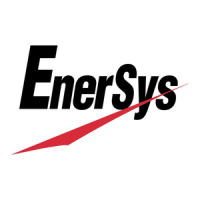310922001-J0 Rev A
Cordex® CXPS-E105 Edge Power Systems
User Guide
7.3 AC feeder protection and sizing
To maximize system reliability, each feed should have a dedicated protection feeder breaker located at the AC
distribution panel. The feeder breaker can also act as the disconnect device for the connected modules.
7.4 AC wiring
Ensure that all modules are removed from the shelf. Refer to customer connections drawing. The shelf incorporates
IEC receptacles, which require line cords with C19R type plugs (19-inch systems) or with terminal blocks (19-inch or
23-inch systems). Contact Alpha Technologies Ltd. for information on available cords.
7.5 DC wiring
DC output wire must be UL approved XHHW or RHH/RHW (RW90 type for Canadian users). Control and sense
wires must be UL approved Style 1015 (TEW type for Canadian users).
Terminate the cable leads with appropriate crimp lugs.
Secure the positive and negative DC output cables to the shelf output post of the correct polarity; for example
+Vcable to +Vpost. Ensure that the washers are placed on the bolts in the same order in that they were shipped
from the factory.
Connect the common output leg of the rectifier system to the ground. This is typically done at the load common
termination point.
7.6 System and battery connections
Refer to guidelines supplied with the load equipment. Distribution cables are typically sized to provide a 0.5 volt
loop drop at full load and to meet ampacity requirements of the protection fuse or circuit breaker.
Size the battery cables for a 0.25 volt drop from the battery to the power system at full load, including anticipated
additional loads. The cables must also meet ampacity requirements. Cables terminating directly on battery posts
or connection details must be secured so that there is no stress on the battery posts. To reduce corrosion, use
lead plated lugs and lead plated or stainless steel hardware on all terminations of vented batteries.
Prepare, route, and connect cables from the power system to the battery termination points. Burnish the
terminating points and apply a corrosion-inhibiting agent, such as NO-OX-ID®, to all battery terminal connections.
Do not make the final connections to the live batteries. Switch o the battery contactors or remove the battery
fuses. See system startup procedure before connecting batteries online.
CAUTION
To minimize EMI disturbances, route the AC input wires in flexible or rigid conduit and located as
far away as possible from the DC power wires.
WARNING
Leave the cables or busbars disconnected at the battery and verify the output polarity using a
voltmeter. Make the battery connections only after all other wiring is complete.
WARNING
Ensure that the correct polarity is used for all input cable terminations.
CAUTION
To reduce the risk of electrical shock, insulate the barrel section of the lug with clear heat shrink
tube and be careful when connecting and removing cables.

